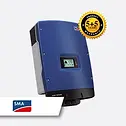Connecting to better
Choose and compare
Inverters.
Utility Choice offers a diverse selection of solar inverters. Below, you can explore and compare some of the most popular models. Your choice will primarily depend on your power supply type, which generally falls into two categories: single-phase and three-phase solar inverters.
Single-phase Inverters
Single-phase power supplies are commonly found in small to medium-sized homes.
A single-phase inverter is designed to connect to and export power through just one phase. While properties with a three-phase grid connection can still use a single-phase inverter, it will only be linked to one of the three phases.

SolarEdge Solar Inverter
3, 5, 8, 10kW
Module-level optimisation
Energy Smart Management
WiFi to SolarEdge monitoring
99% efficiency
12-year warranty
AC & DC battery compatible

Huawei Inverters
3, 5kW
Dual tracking
Australian office in Sydney
WiFi to FusionSolar monitoring
97.8% efficiency
10-year warranty
DC battery input

SMA Sunny Boy Inverter
3, 5, 6kW
Dual tracking
German Engineered
WiFi to Sunny Portal monitoring
97% efficiency
10-year (5+5) warranty
AC battery compatible

Goodwe Solar Inverters
3, 5, 8, 10kW
Dual tracking
Australian office in Melbourne
WiFi to SEMS Portal monitoring
97.8% efficiency
10-year warranty
AC battery compatible

Fronius Primo Solar Inverters
3, 5, 8kW
Dual tracking
Made in Austria
WiFi to Solar. web monitoring
97% efficiency
10-year (5+5) warranty
AC battery compatible

Solax X1 String Inverter
3, 5kW
Dual-tracking
Australian office in Melbourne
WiFi to SolaX Portal monitoring
97.8% efficiency
12-year (6+6) warranty
AC battery compatible
Three-phase Inverters
Three-phase power supplies are commonly found in larger homes and commercial properties.
A three-phase inverter, however, connects to all three phases and distributes power evenly across them. To install a three-phase inverter, a three-phase grid connection is required. Since most residential properties have a single-phase connection, single-phase inverters remain the most widely used option.

SMA Inverters
Sunny Tripower
Available in 5, 6, 7, 8, 9kW
AC battery compatible
AC battery compatible
DC input voltage of up to 1,000V
10-year (5+5) warranty

Fronius Symo Solar Inverters
Fronius Symo
3 Phase Range from 3kW to 20kW
AC battery compatible
AC battery compatible
Dual tracking
10-year (5+5) warranty

SolarEdge Solar Inverter
Three-Phase
5, 8, 10kW
AC battery compatible
AC battery compatible
Module-level optimisation
12-year warranty

Huawei Inverters
SUN2000-5KW TL-M0 SUN2000-10KWTL-M0
5, 10kW
AC-DC, 5-6kW battery ready
consumption (5kW)
Smart Meter – Export control and load
Smart Meter – Export control and load
Dual tracking
Achieve maximum efficiency of 98.65%

Goodwe Solar Inverters
GW10KL-DT
10kW
Reliable grid support capabilities
Suitable for commercial and industrial roofs
Suitable for commercial and industrial roofs
Dual MPPT
10-year (5+5) warranty
Our partner's partner
We are the Best Utility Market Place in Australia.


